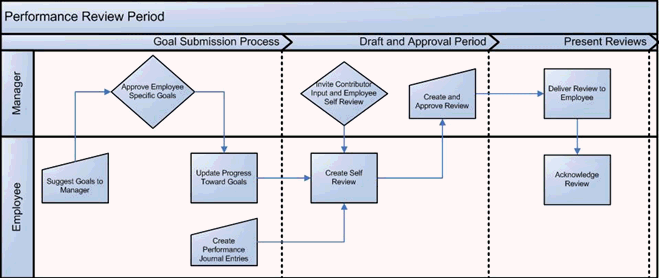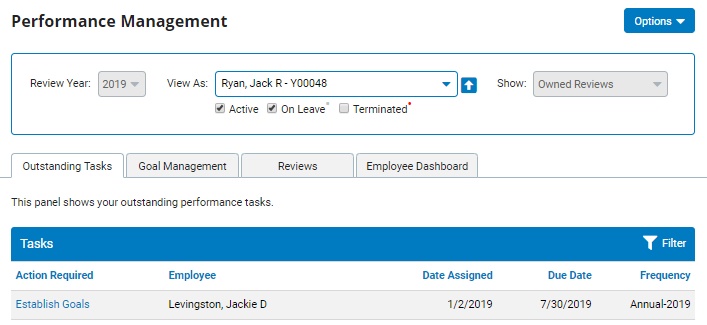
Through the Performance Dashboard, both performance administrators and managers are able to easily navigate through the various aspects that are encompassed in a performance review cycle. This includes the tools to monitor an employee's overall evolvement (such as progress towards defined goals), take and share notes of employee observations (journal entries), and ultimately the creation and presentation of the performance review to the employee.
While each organization may choose to manage a different workflow, a general performance cycle that may be encountered is illustrated below:

To access and navigate the Performance Dashboard:
1. On the Menu, click HR Administration > Performance ManagementHR Administration > Performance Management.

The Performance Management DashboardPerformance Management Dashboard page displays.

2. If desired, use the on screen filters to alter the information displayed in any of the Performance Dashboard tabs:
Review Year: Choose to see performance items that are associated with a certain performance review year.
View As: Choose to see the Performance Dashboard as another manager would see it (focusing on the action items and review items that are owned by the selected manager).
Show: Choose if you would like to view performance items for all employees, those whom you are over from an organizational tree standpoint (team reviews), or those whose reviews you are responsible for creating (owned reviews).
Note: For all filters, managers are only able to access performance information for individuals that he/she has been provided Grant Access rights to view.
3. On the Performance Dashboard itself, you will find the following tabs to access (click on the links below to learn more about each one):
Employee DashboardEmployee Dashboard
The Employee Dashboard provides users the ability to select a single employee and view all of the performance reviews, goals, and journals for that individual. This view can be refined to a specific year or expanded to include data from all recent performance years.
The Performance Administrator (PA) will have an important role in the overall setup and maintenance of the Performance Management process. Many of the Performance Administrators in a company will also serve as managers and complete reviews for their direct reports as well as manage the review process for the company. Therefore, as the PA, you will also need to have an understanding of Manager’s Role in the Performance Management process.
Note: The PA is typically the same role as the HRA identified for your company and will, therefore, already have PA access rights. If your company would like to assign another manager to serve as the PA, they need to have Performance Administrator access rights set for them. See the Related Help Topic for more information on granting access to the Performance Administrator functional utility.
Managers will have the ability to track the performance review process throughout the year. They will have the ability to view completion reports of the reviews, as well as step in as a backup manager and complete a review if the direct manager will not be able to complete the review as scheduled. The reporting manager will also be notified once lower level managers have completed their direct reports' reviews and will be asked to approve the reviews and budgets if applicable.
Note: All managers automatically receive access to Performance Management by default; no further access rights are required.
Employees are responsible for completing their Self Review (if invited to do so by their manager) and updating their Performance Journal and Employee Goals throughout the year.
As the PA, the Performance Management process will not be effective until you set up several key components in ExponentHR.
Create a Performance Management OSM Tree (if different from the direct report setup).
Grant Access to all Managers who will need access to Performance Management from the Management view.
Create a Schedule for the Review Year.
Create a Budget to accompany the review (if you are tying compensation to reviews).
Create Review Criteria for the company or for appropriate groups within the company.
Create Company Goals to be associated with particular groups within the company or for the entire company.
Create Additional Evaluation Components to be used by the company.
Related Help Topics
Managing Performance Rating Methodologies
Managing Performance Review Items
Managing Performance Templates
Performance Management Reporting Capabilities